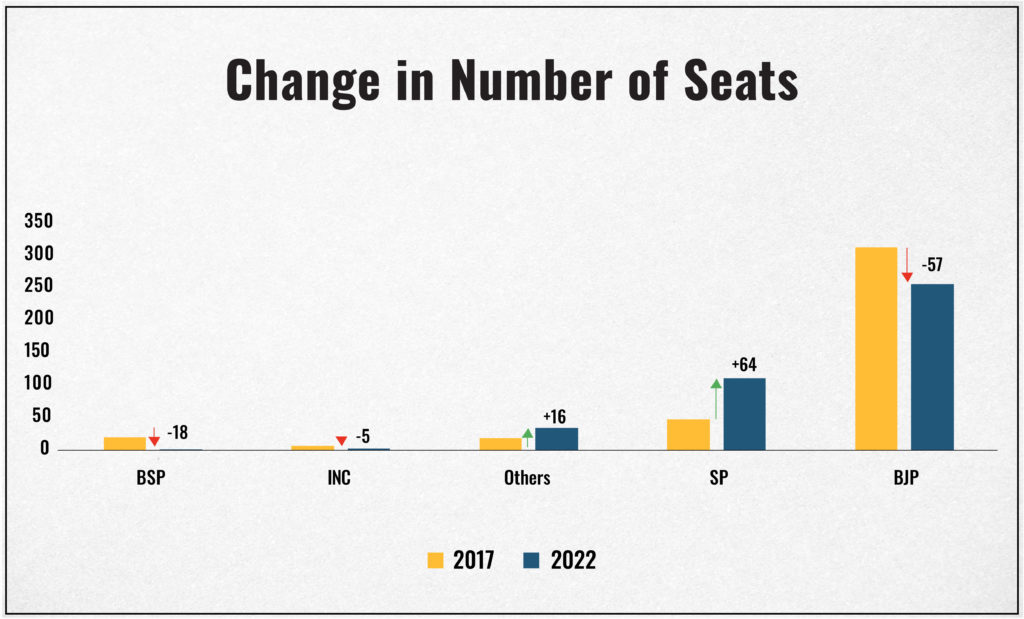Uttar Pradesh Legislative Assembly elections were held in seven phases, from 10 February to 7 March 2022, to elect all 403 members for the 18th Uttar Pradesh Legislative Assembly. The results were declared on 10 March 2022.
Seat Share/ party-wise

The 2022 Uttar Pradesh elections were, by all measures, the grandest electoral exercise in India after the General Elections. The total electorate numbers stood at 15.03 crores- an increase of 90.30 lakh voters from 2017’s number of 14.12 crores. Another major point is that BJP made history by winning consecutive elections in Uttar Pradesh at the end of a five-year term. The only CM to accomplish this before was Dr Sampurnanand- UP’s second Chief Minister back in 1957.
Party-wise Graph


The BJP’s victory stands out as impressive and hints at Yogi Adityanath’s further entrenchment in UP. BJP increased its vote share from 39.7% to 41.3%, even though there was a substantial decline in seats – 255 against 312 in 2017. But even this drop did not make BJP’s position in UP assailable.
Vote share Change Graph


Akhilesh Yadav’s SP, the second-largest party rose from 47 seats in 2017 to 111 seats in 2022- an increase of 10.24%. The promise of epic events continues with the tremendous loss of BSP. The once-powerful BSP ended up with just one victory, winning Rasara seat in Ballia district where its sitting MLA Umashankar Singh got 87,887 votes (43.82%)- 6,583 votes advantage over his challenger from SBSP. Interestingly, BSP gained 12.88% of the vote share, making it the third-largest party and even then, the victory turned out to be one less than INC’s verdict. The grand old party was reduced to two seats: Rampur Khas in Pratapgarh and Pharenda in Maharajganj- a dip of 3.92% vote to 2.33% popular vote share, from its 2017 position of 6.25%.
The smaller parties played their roles to great effect. SP’s main ally RLD contested 33 seats and won 8 with a vote share of 2.85%- raising its numbers from the single-seat it won in 2017 and SBSP gained 6 seats. On the other side, NDA members- Nishad Party and Apna Dal (Sonelal) won 6 and 12 seats respectively.
Margins

Each of the prominent parties displayed areas of dominance and weak victories.
BJP’s Sakendra Pratap Verma from Kursi defeated SP’s Rakesh Verma with a margin of 217 votes- this is one of the tiniest margins of victory in the state. On the other hand, BJP’s Pankaj Singh from Noida defeated SP’s Sunil Chowdhary with 1,81,513 votes.
SP’s biggest winner was Shivpal Singh Yadav who defeated BJP’s Vivek Shakya with a margin of 90,979 votes and SP’s weakest winner was Swami Omvesh from Chandpur, who managed to avoid defeat with 234 votes. JD(L)’s two victories were secured from Babaganj and Kunda based on a margin of 15,767 and 30,315 votes respectively.
Apna Dal’s (Sonelal) biggest victory was Vishwanathganj with a 48,052-vote advantage over SP, and a measly 1,048 vote advantage over SP in Manikpur. SBSP secured its biggest win at Zahoorabad with 45,632 votes and weakest victory with 5495 at Mahadewa, both over BJP. RLD gained an advantage of 29,508 votes at Chhaprauli over a BJP candidate and secured Sadabad with a 6437 votes advantage, again, over a BJP candidate. The Nishad candidate at Khadda won with 41451 votes and the one at Shahganj won with an advantage of 719 votes.
Candidates


Overall, 4442 candidates, including 569 female candidates contested across 403 assembly constituencies in 75 districts. The result data states that 356 male and 47 female candidates qualified to join the legislative assembly. A gender-wise success rate of 8.39% for men and 9.17% for women.
Lota Candidates


Compared to the number of candidates in the field, Lota figures are pretty low at 174. Out of which 37 were successful. BJP as a party benefited most from Lota candidates and the second most successful was SP. The success rate for BJP was 56.76% and for SP it was 43.24%.
Data analyzed and visualized by Harleen and Akanksha Gakhar
